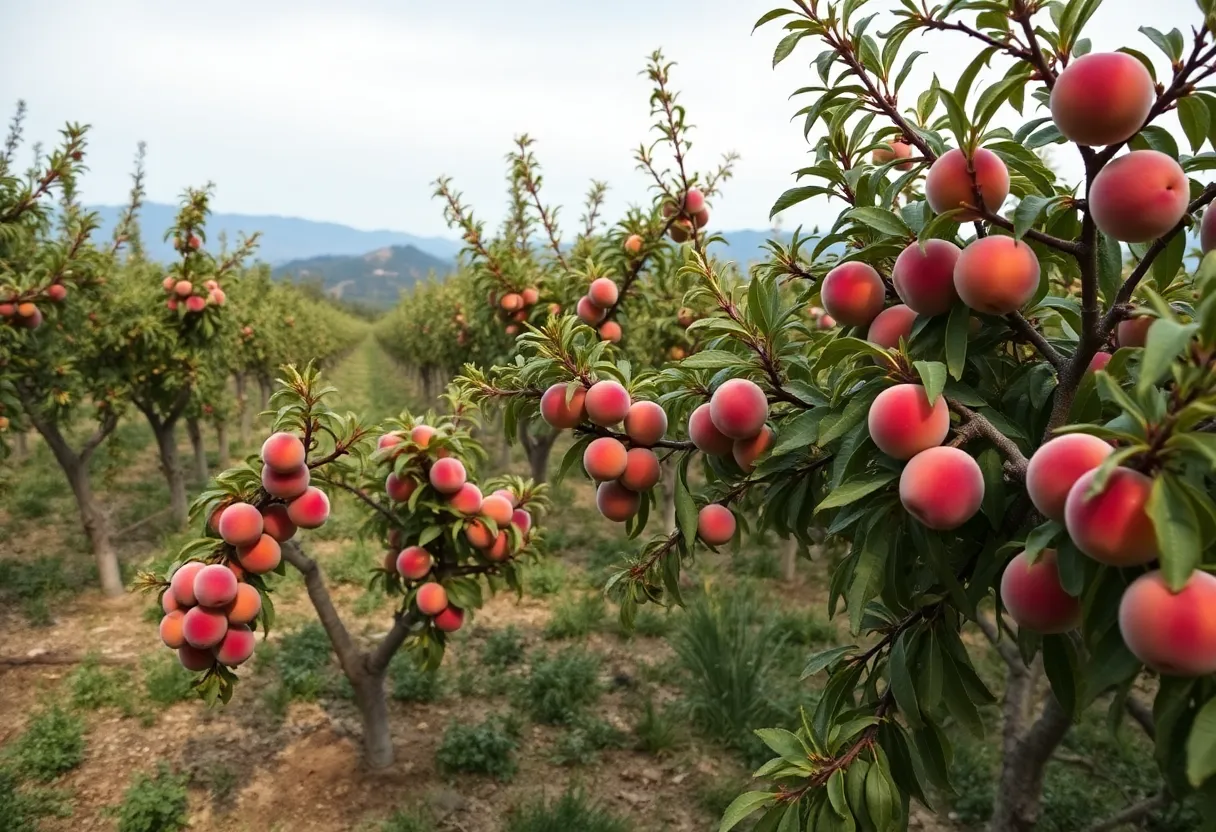News Summary
The peach harvest in California’s Central Valley has seen a significant 30% decline this year due to warmer winter temperatures disrupting essential tree cycles. Farmers are concerned as the altering climate impacts both fruit production and prices for consumers. The situation extends to South Carolina and Georgia, where crop losses are severe, highlighting the urgent need for adaptive farming strategies. Despite challenges, some producers are maintaining output through traditional methods while exploring innovative solutions to safeguard their livelihoods.
California Peach Harvest Faces 30% Decline Due to Climate Change
In California’s Central Valley, the Masumoto Family Farm is grappling with a significant 30% decrease in peach harvests this year. The decline is attributed to warm winter temperatures that disrupted the trees’ vital sleep cycles, leading to a reduction in their nutrient regulation. This downturn has profound implications for farmers who depend on the short, intense 12-week harvesting period for their entire annual income.
Impacts of Warmer Winters on Peach Production
The consistent warm weather patterns throughout the past winter resulted in inconsistent cold temperatures, which have critically affected various stone fruits, including peaches. It has been reported that some growers have even faced complete crop failures as a direct consequence of these climate fluctuations. Agricultural experts emphasize that the peach trees require a specific number of hours below 45 degrees Fahrenheit to maintain healthy sleep cycles necessary for proper growth and fruit development. With warmer winters interrupting this cycle, trees have struggled to store energy effectively, which is crucial for fruit production.
Increased Costs for Consumers
The repercussions of a diminished peach yield are also being felt in supermarkets, where the prices of peaches have risen sharply. The cost of yellow peaches has surged by 23 cents per pound, while the price of white peaches has increased by 17 cents per pound. As these efforts to cope with climate fluctuations continue, consumers are witnessing the impact of declining peach supplies on availability and pricing.
Production Strategies and Challenges
Despite the overwhelming challenges posed by climate change, the Masumoto family has managed to maintain production levels to some extent, utilizing older groves and traditional irrigation techniques. Their method, known as furrow irrigation, preserves soil health better than modern approaches that prioritize individual plant requirements. This setup has allowed them to pack and ship approximately 10,000 pieces of fruit daily. However, many in the agricultural sector remain concerned about the long-term viability of peach farming in the face of persistent climate instability.
South Carolina’s Peach Crop Plummets
Further east in South Carolina, peach producers are also experiencing hardships, particularly following a late freeze that decimated approximately 70% of their harvest. This trend is echoed in neighboring Georgia, where the crop loss is even more severe, with only 5% of the expected yield remaining. Peach farming in these regions is notably labor-intensive and sensitive to weather conditions, making it a precarious venture compared to more resilient crops.
Mitigation Strategies for Farmers
To combat the adversities brought on by climate change, farmers are resorting to various strategies. Some are investing in protective measures such as wind machines and burning straw to shield crops from frost damage. Others are exploring options like crop insurance to safeguard their financial stability in light of the increased risks associated with their crops.
Future Prospects
Experts advise cautious optimism regarding future peach production, citing advancements in agricultural research focusing on peach varieties that require fewer chill hours to thrive. While these developments may provide some relief, the pressing challenges from climate change, coupled with the resurfacing threat of diseases like phony peach disease (PPD), remain significant concerns.
Economic Significance of Peach Farming
The economic contribution of peach farming is substantial, with around 15,500 acres under cultivation generating over $98 million in South Carolina alone. This highlights the importance of peaches not only as a profit-generating crop but also as a core element of regional identity and economy. Increased awareness of the obstacles faced by peach farmers may foster better understanding and support within the community for this vital industry as it navigates the challenges posed by climate change.
Deeper Dive: News & Info About This Topic
- CBS News
- Wikipedia: Climate change and agriculture
- Macon.com
- Encyclopedia Britannica: Peach (fruit)
- The Guardian
- Google Search: climate change peach farming
- New York Times
- Google Scholar: peach harvest climate change
- ScienceDirect
- Google News: peach harvest news
- The Atlantic
- Fox Weather

Author: STAFF HERE HUNTINGTON BEACH
The Huntington Beach Staff Writer represents the experienced team at HEREHuntingtonBeach.com, your go-to source for actionable local news and information in Huntington Beach, Orange County, and beyond. Specializing in "news you can use," we cover essential topics like product reviews for personal and business needs, local business directories, politics, real estate trends, neighborhood insights, and state news affecting the area—with deep expertise drawn from years of dedicated reporting and strong community input, including local press releases and business updates. We deliver top reporting on high-value events such as the Huntington Beach Surf City USA Marathon, the U.S. Open of Surfing, Fourth of July celebrations at the Huntington Beach Pier, and community festivals at Huntington Beach Central Park. Our coverage extends to key organizations like the Huntington Beach Chamber of Commerce and Visit Huntington Beach, plus leading businesses in retail, hospitality, and outdoor recreation that drive the local economy. As part of the broader HERE network, including HEREAnaheim.com, HERECostaMesa.com, HERESantaAna.com, and HERELosAngeles.com, we provide comprehensive, credible insights into Southern California's dynamic landscape.





